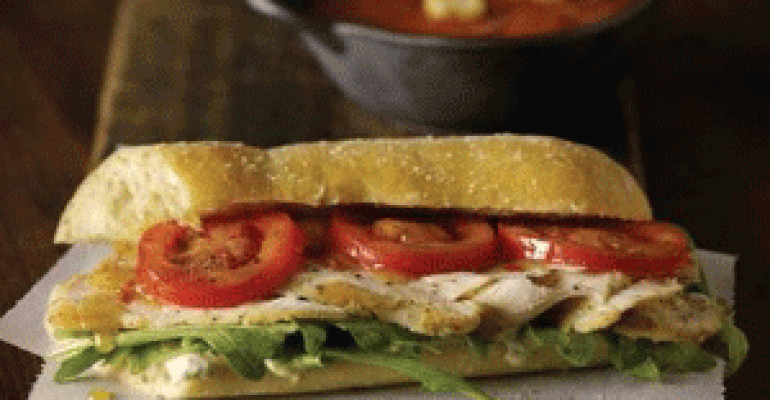In this season of calorie counting and New Year’s resolutions, restaurant chains are reaching out to health-focused consumers with diet-friendly options.
For some, the move may also be a reaction to menu-labeling requirements in New York, California and other markets aimed at making calorie content more transparent to consumers. Proposed federal health care legislation is also expected to include menu-labeling requirements.
However, with the push for more calorie disclosure comes questions about the accuracy of nutrition data. A study in this month’s Journal of the American Dietetic Association indicates that not all calorie postings at restaurant chains and on frozen-food labels are correct.
This month, chains such as Starbucks, Corner Bakery, Applebee’s, Dunkin’ Donuts, Taco Bell, and KFC are promoting new lower-calorie options.
Starbucks will soon debut four new hot panini sandwiches, each with fewer than 400 calories, at more than 4,200 stores with warming ovens. The warmed-to-order sandwiches include a Chicken Santa Fe panini; a roasted tomatoes and mozzarella panini; a ham and Swiss panini; and a tuna melt panini.
In addition, Starbucks’ U.S. stores will be adding a new line of snacks with 220 calories or fewer per serving, such as portion-controlled Annie’s Snacks; multigrain and sweet potato chips by FoodShouldTasteGood; grab-and-go Kind Bars; Lucy’s Cookies; fruit-based Peeled Snacks; Peter Rabbit brand organic treats; nut-based Sahale Snacks; Two Moms in the Raw granola mixes; and Stretch Island Fruit Company-brand fruit leather.
Starbucks is also promoting a new vanilla rooibos full-leaf tea, which is calorie free without milk or sugar, and the Skinny Cinnamon Dolce Latte and Skinny Vanilla Lattes, which each have fewer than 90 calories per 12-ounce size.
Dallas-based Corner Bakery Café this week introduced “100 under 600,” a program showcasing more than 100 soup, salad and sandwich combinations under 600 calories at its more than 100 units.
“So many people give up on their resolution to eat healthy because they feel like they have to sacrifice their favorite foods,” said Ric Scicchitano, Corner Bakery’s vice president of food and beverage. “Our guests find that it’s easier to keep their resolutions when they dine with us, because, with over 100 different soup, salad and sandwich combinations under 600 calories, they can enjoy great tasting, but sensible meals year round without making drastic changes to their diet.”
Among the options: chicken pesto on ciabatta with roasted tomato basil soup; a club panini and chicken noodle soup; or the D.C. Chicken Salad Sandwich with a Caesar salad. The full list is posted on the chain’s website at www.CornerBakeryCafe.com/100under600.
Guests also are invited to respond to questions on healthy eating, nutrition and exercise by following Corner Bakery on Twitter for a chance to win a free combo meal.
Dunkin’ Donuts, a 8,800-unit subsidiary of Canton, Mass.-based Dunkin’ Brands Inc., said this month that any of its breakfast sandwiches and wraps can now be ordered with egg whites to reduce calories and fat.
The company’s DDSMART menu, a lineup of more healthful food items and beverages, now includes a new low-fat cranberry-orange muffin, with 390 calories and 3 grams of fat.
Applebee’s in mid-December rolled out five new menu items, each under 550 calories, at its more than 2,000 units nationwide in anticipation of guests’ New Year’s resolutions. The new dishes include Grilled Shrimp and Island Rice; Asiago Peppercorn Steak served with herb potatoes and vegetables; Grilled Dijon Chicken and Portobellos, Spicy Shrimp Diavolo; and Asian Crunch Salad. The menu items range in price from $7.99 to $12.99.
Nancy Mays, Applebee’s executive director for communications, said customer feedback so far has been positive.
“It’s early still, but we are feeling the consumers are responding,” she said.
Taco Bell, a brand owned by Louisville, Ky.-based Yum! Brands Inc., recently launched an ad campaign featuring Christine Dougherty, a 27-year-old who lost 54 pounds by dining several times a week off of Taco Bell’s Fresco menu of low-calorie options. The company has dubbed it the “Drive-Thru Diet” — though they are being careful not to suggest it is a weight-loss program.
The highlighted menu items include seven options ranging from a Fresco Crunchy Taco at 150 calories and 7 grams of fat, to a Fresco Burrito Supreme Chicken at 340 calories and 8 grams of fat.
The chain also is inviting customers to make their own “frescolutions” to make smarter dining choices and Tweet in to motivate others. Tweeters may win free Fresco dining for a year, up to a $550 value.
KFC, another Yum brand, in November began promoting its 395-calorie Kentucky Grilled Chicken meal by offering it for $3.95 — or a penny per calorie — through the holiday season. The pricing promotion is over, but officials note the number of calories hasn’t changed and remains a more-healthful option on the menu. The meal includes a grilled chicken drumstick and thigh, green beans and mashed potatoes with gravy.
Researchers, however, warn that the calorie counts posted by restaurants across the country may be wrong.
In a study published in the Journal of the American Dietetic Association’s January issue, Tufts University researchers analyzed 29 quick-service and casual-dining restaurant dishes and found they contained an average of 18 percent more calories than what was posted.
Researchers blamed variations in ingredients or preparations, and noted that most of the discrepancies fell within the U.S. Food and Drug Administration’s allowed 20 percent margin of error.
AWendy’s Ultimate Chicken Grill, for example, reportedly had 9 percent more calories than the 320 listed. The Sichuan-style asparagus at P.F. Chang’s China Bistro had more than twice the 200 calories stated, and a McDonald’s McChicken sandwich, listed at 360 calories, had about 3 percent more.
Some items came in lower than the reported number of calories, such as Domino’s large thin-crust pizza, which had about one-third fewer calories than the 180 per serving posted.
Contact Lisa Jennings at [email protected].




